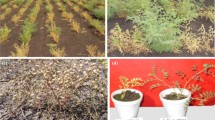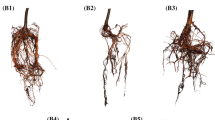Summary
Quantitative inheritance of resistance to Phytophthora pod rot (Ppr) was studied in cocoa hybrid progeny from 12 Trinitario x Amazonian crosses and their reciprocal crosses. The crossing scheme was similar to a factorial design. Disease was assessed by the number and percentage of infected pods on each tree. Highly significant differences due to general combining abilities (GCA) were obtained for all characters, except for the GCA of Trinitario on total pod production. Differences for specific combining ability (SCA) were not significant for all characters. There were no significant differences between reciprocal crosses. The Trinitario clone K82 provided the only source for the hybrid progenies of strong Ppr resistance to the hybrid progenies, while K20 provided moderate resistance. Other parental clones — KA2-101, KA5-201, KEE 2, KEE 5, and KEE 52 — produced progenies which were susceptible to Ppr. It is evident that resistance to Ppr in cocoa is inherited additively. Maternal and cytoplasmic effects were assumed to have no influence on inheritance of resistance. It is also concluded that resistance to Ppr of the kind shown by K82 is likely to be horizontal resistance. Breeding for high-yielding cultivars combined with Ppr resistance is the most effective way of controlling Ppr of cocoa on the crops of growers with small holdings in Papua New Guinea.
Similar content being viewed by others
References
Amponsah JD (1988) Studies on field resistance of cocoa varieties to Phytophthora palmivora (Butl.) Butl. infection. In: Proc 10th Int Cocoa Res Conf, Santo Domingo, Dominican Republic, pp 557–567
Arentz F (1986) A key to Phytophthora species found in Papua New Guinea with notes on their distribution and morphology. Papua New Guinea J Agric For Fish 1–4:9–18
Asare-Nyako A, Amponsah JD (1973) Indications of heritability of resistance of a cocoa cultivar to Phytophthora palmivora pod rot in Ghana. Biologie 20:47–49
Blaha G, Lotode R (1977) Contribution to the knowledge of the mode of inheritance of resistance to black pod disease (Phytophthora palmivora) in cocoa in Cameroon. Cafe Cacao The 21:179–196
Comstock RE, Robinson H (1952) Estimation of the average degree of dominance of genes. In: Gowan JW (ed) Heterosis. Iowa State College Press, Ames, pp 495–516
Dakwa JT (1977) Macro-and micro-climate in relation to black pod disease in Ghana. In: Proc 5th Int Cocoa Res Conf, Ibadan, Nigeria, pp 370–374
Draper NR, Smith H (1966) Applied regression analysis. Wiley, New York London Sydney
Gregory PH (1985) Disease of cocoa. In: Lass RA, Wood GAR (eds) Cocoa production, present constraints and priorities for research. World Bank Techn Paper 39:43–48
Gregory PH, Maddison AC (1981) Epidemiology of Phytophthora on cocoa in Nigeria. Commonwealth Mycology Institute, Kew, England
Hicks PG (1967) Observations on the diseases and conditions of cocoa pods in Papua New Guinea — pod losses 1962–1965. Papua New Guinea Agric J 19:5–9
Hicks PG (1975) Phytophthora palmivora pod rot of cacao in Papua New Guinea — Investigations 1962–1971. Papua New Guinea Agric J 26:10–16
Kennedy AJ, Lockwood G, Simmonds NW, Tan GY (1987) Cocoa breeding: past, present and future. Cocoa Growers Bull 38:5–22
McGregor AJ (1981) Phytophthora pod rot research in Papua New Guinea since 1971. In: Proc 7th Int Cocoa Res Conf, Douala, Cameroun, pp 339–345
Park YS, Gerhold HD (1986) Population hybridization in Scotch pine (Pinus Sylvestris L.) I. Genetic variance components and heterosis. Silvae Genet 35:159–165
Partiot M (1975) Horizontal resistance in cacao to Phytophthora sp. Methods of early evaluation. Cafe Cacao The 19:123–136
Ram C, Figueiredo JM de (1971) Comparative studies of different Phytophthora palmivora isolates. Rev Theobroma 1:3–8
Rocha HM (1974) Breeding cacao for resistance to Phytophthora palmivora. In: Gregory PH (ed) Phytophthora disease of cocoa. Longman, London, pp 211–218
Rocha HM, Vello F (1971) Estudos sobre resistencia do cacau (Theobroma cacao L.) a Phytophthora palmivora (Butl.) Butl. In: Proc 3rd Int Cocoa Res Conf, Accra, Ghana, pp 430–438
Simmonds NW (1979) Principles of crop improvement. Longman, London
Sitapai EC, Kennedy AJ (1988) Genetic aspects of resistance to Phytophthora palmivora disease. In: Proc 10th Int Cocoa Res Conf, Santo Domingo, Dominican Republic, pp 633–636
Soria VJ (1974) Sources of resistance to Phytophthora palmivora. In: Gregory PH (ed) Phytophthora disease of cocoa. Longman, London, pp 197–202
Soria VJ (1978) The breeding of cacao (Theobroma cacao L.). In: Methods of crop breeding. Proc Symp Trop Agric Res. Tropical Agricultural Research Centre, Ibaraki, Japan, pp 161–168
Soria VJ, Esquivel O (1970) Herencia a la resistencia a enfermedades del cacao. Resistencia a Phytophthora palmivora. Cacao (Costa Rica) 15:5–6
Spence JA (1961) Black-pod disease of cocoa. I. A comparison of isolates of Phytophthora palmivora (Bull.) Bull. Ann Appl Biol 49:717–722
Tan GY (1981) Breeding for disease resistance to vascular-streak dieback, canker, and black pod in hybrid cocoa. Proc 8th Int Cocoa Res Conf, Cartagena, Columbia, pp 731–734
Tan GY (1987) Cocoa breeding in Papua New Guinea and its relevance to pest and disease control. FAO workshop on Assessment of Plant Protection Risks for cocoa. Lembang, Indonesia
Tan GY (1990) Combining ability analysis of yield and its components in cocao (Theobroma cacao). J Am Soc Hortic Sci 115 (in press)
Tan GY, Tan WK (1988) Genetic variation in resistance to vascular-streak dieback in cocoa (Theobroma cacao). Theor Appl Genet 75:761–766
Thorold CA (1956) Observations on cacao pod production in relation to the incidence of black-pod disease, caused by Phytophthora palmivora. J Hortic Sci 31:149–155
Thrower LG (1960) Observations on the disease of cacao pods in Papua New Guinea. I. Fungi associated with mature pods. Trop Agric 37:111–120
Toxopeus H (1974) Breeding for black pod resistance in Theobroma cacao L. In: Gregory PH (ed) Phytophthora disease of cocoa. Longman, London, pp 203–210
Vanderplank JE (1963) Plant disease: epidemics and control. Academic Press, London New York
Zentmyer GA (1988) Taxonomic relationships and distribution of species of Phytophthora causing black pod of cacao. In: Proc 10th Int Cocoa Res Conf, Santo Domingo, Dominican Republic, pp 391–395
Zentmyer GA, Mitchell DM (1971) Mating types in Phytophthora palmivora. In: Proc 3rd Int Cocoa Res Conf, Accra, Ghana, pp 494–497
Author information
Authors and Affiliations
Additional information
Communicated by G. S. Khush
Rights and permissions
About this article
Cite this article
Tan, G.Y., Tan, W.K. Additive inheritance of resistance to pod rot caused by Phytophthora palmivora in cocoa. Theoret. Appl. Genetics 80, 258–264 (1990). https://doi.org/10.1007/BF00224396
Received:
Accepted:
Issue Date:
DOI: https://doi.org/10.1007/BF00224396




